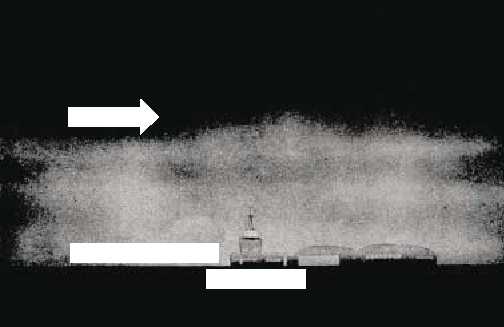ADVECTION FOG.—Advection fog is the name
given to fog produced by air in motion or to fog formed
in one place and transported to another. This type of fog
is formed when warmer air is transported over colder
land or water surfaces. Cooling from below takes place
and gradually builds up a fog layer. The cooling rate
depends on the wind speed and the difference between
the air temperature and the temperature of the surface
over which the air travels.
Advection fog can form only in regions where
marked temperature contrasts exist within a short
distance of each other, and only when the wind blows
from the warm region toward the cold region. (See fig.
5-3.) It is easy to locate areas of temperature contrast on
the weather map, as they are usually found along
coastlines or between snow-covered and bare ground.
Sea Fog.—Sea fog is always of the advection type
and occurs when the wind brings moist, warm air over a
colder ocean current. The greater the difference
between the air temperature and the ocean temperature,
the deeper and denser the fog. Sea fog may occur
during either the day or night. Some wind is necessary,
not only to provide some vertical mixing, but also to
move the air to the place where it is cooled. Most
advection fogs are found at speeds between 4 and 13
knots. Sea fogs have been maintained with wind speed
as high as 26 knots. They persist at such speeds because
of the lesser frictional effect over a water surface.
Winds of equal speed produce less turbulence over
water than over land.
Sea fogs, which tend to persist for long periods of
time, are quite deep and dense. Since the temperature of
the ocean surface changes very little during the day, it is
not surprising to hear of sea fogs lasting for weeks. A
good example of sea fog is that found off the coast of
Newfoundland.
Land Advection Fog.—Land advection fog is
found near large bodies of water; that is, along
seacoasts and large lakes. Onshore breezes bring
maritime air over a land surface, which has cooled by
radiation at night. (See fig. 5-4.) Also, fogs may form
over the ocean and be blown over the land during either
the day or the night. Another situation favorable to fog
formation is one in which air flows from warm, bare
ground to snow-covered ground nearby.
Land advection fog cannot exist with as high wind
speed as the sea type because of the greater turbulence.
It dissipates in much the same fashion as radiation fog.
However, since it is usually deeper, it requires a longer
time to disperse.
Steam Fog.—Steam fog occurs within air masses;
but, unlike other air-mass fogs, which are formed by the
cooling of the air temperature to the dew point, steam
fog is caused by saturation of the air through
evaporation of water. It occurs when cold air moves
5-8
AG5f0503
WARM AIR
COOLING BY CONTACT
COLD GROUND
Figure 5-3.—Advection fog.

